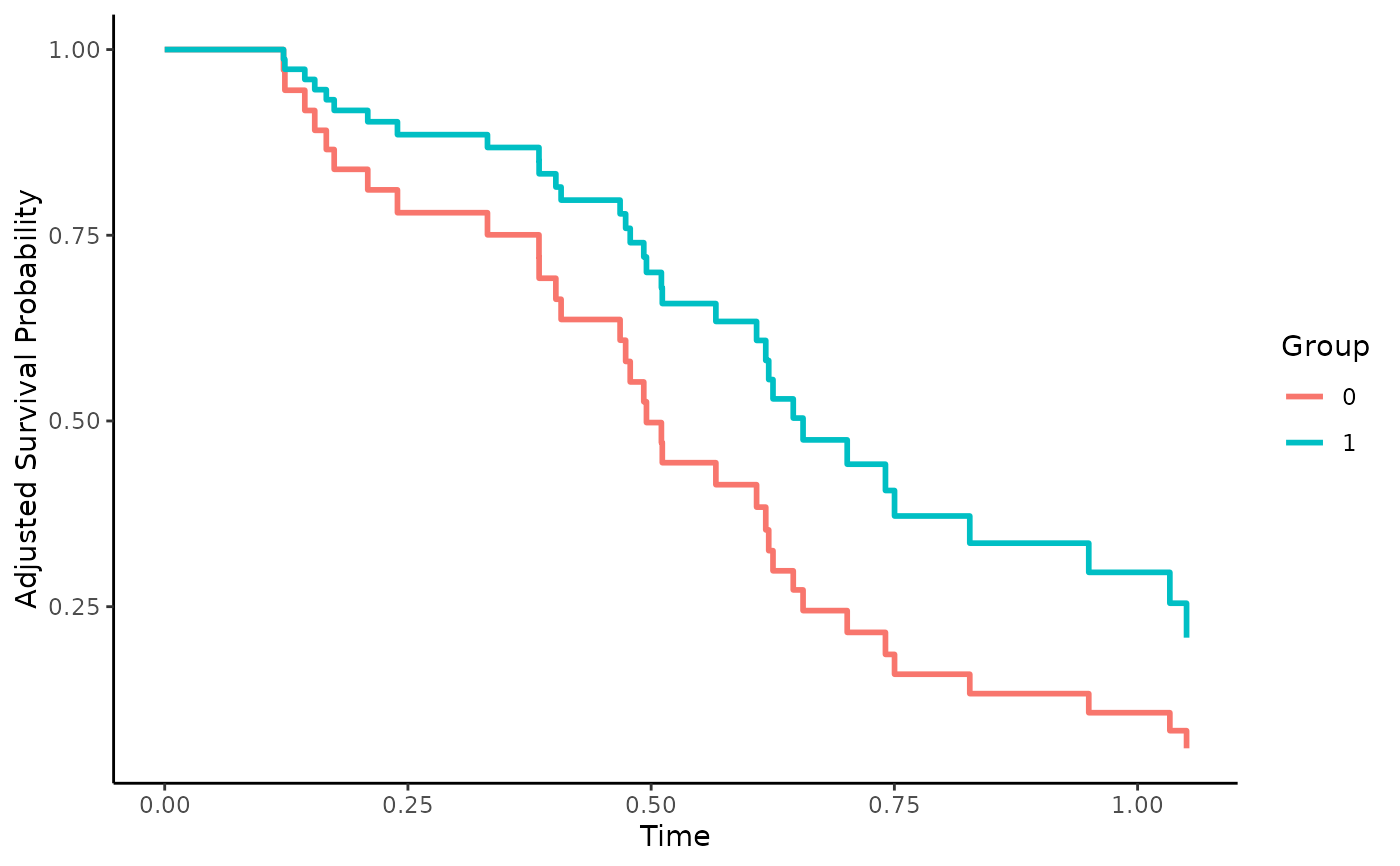
Direct Adjusted Survival Curves
surv_direct.RdThis page explains the details of estimating confounder-adjusted survival curves using a previously fit Cox-Regression model for single event time-to-event data using Direct Standardization (method="direct" in the adjustedsurv function). All regular arguments of the adjustedsurv function can be used. Additionally, the outcome_model argument has to be specified in the adjustedsurv call. Further arguments specific to this method are listed below.
Arguments
- outcome_model
[required] Must be a previously fit model object including
variableas independent variable. Apart from the classiccoxphmodel this function also supports a variety of other models. Seemodels_surv_directfor a list of supported model objects and some more details.- verbose
Whether to print estimation information of the
atefunction in the riskRegression package. Ignored ifoutcome_modelis not acoxphobject. Defaults toFALSE.- predict_fun
A function which should be used to calculate the predicted survival probabilities given covariates and some points in time. This argument only needs to be specified if the kind of model supplied in the
outcome_modelis not directly supported. Seemodels_surv_directfor more information. Defaults toNULL.- ...
Further arguments passed to
ateifoutcome_modelis acoxphobject. Otherwise the additional arguments are passed to the respectivepredictmethod. Seemodels_surv_directfor more information.
Details
Type of Adjustment: Requires a model describing the outcome mechanism. See
models_surv_directfor a list of supported model objects and some more details.Doubly-Robust: Estimates are not Doubly-Robust.
Categorical groups: Any number of levels in
variableare allowed. Must be a factor variable.Approximate Variance: Calculations to approximate the variance and confidence intervals are available only if
outcome_modelis acoxphobject. Theatefunction is used for the calculation in that case. Bootstrap confidence intervals can however be calculated with all supported models. See?adjustedsurvfor more information on bootstrapping.Allowed Time Values: Allows both continuous and integer time.
Bounded Estimates: Estimates are guaranteed to be bounded in the 0 to 1 probability range.
Monotone Function: Estimates are guaranteed to be monotone.
Dependencies: This method relies on the riskRegression package. Depending on
outcome_modelother packages might be needed. Seemodels_surv_directfor more details.
This method works by executing the following steps: (1) First a model is fitted which describes the outcome mechanism (time-to-event). Next (2) multiple copies of the original dataset are created, one for each possible level of the variable of interest. (3) The variable is then set to one level for all observations in each dataset. (4) The model is used to predict the survival probabilities at some points in time T for each observation in all dataset copies. (5) Those estimated probabilities are averaged for each dataset at each point in time, resulting in adjusted survival probabilities for all levels of the group variable at the specified points in time.
In the literature this method is sometimes called "Direct Standardization", "Corrected Group-Prognosis", "G-Computation" or "G-Formula". If the model in step (1) is "correct"" this method will produce unbiased estimates of the counterfactual survival curves. A model can be called a "correct" model in this context if it can be used to produce unbiased estimates of the true (but unknown) individual survival probabilities given covariates. When used properly this is one of the most efficient methods. More information can be found in the literature listed in the references. The most popular model for describing the outcome mechanism in a time-to-event context is the Cox-regression model (coxph). This function however also supports a variety of other models.
Value
Adds the following additional objects to the output of the adjustedsurv function:
ate_object: The object returned by theatefunction.
References
I-Ming Chang, Rebecca Gelman, and Marcello Pagano (1982). "Corrected Group Prognostic Curves and Summary Statistics". In: Journal of Chronic Diseases 35, pp. 669-674
Robert W. Makuch (1982). "Adjusted Survival Curve Estimation Using Covariates". In: Journal of Chronic Diseases 35.6, pp. 437-443
Xu Zhang, Fausto R. Loberiza, John P. Klein, and Mei-Jie Zhang (2007). "A SAS Macro for Estimation of Direct Adjusted Survival Curves Based on a Stratified Cox Regression Model". In: Computer Methods and Programs in Biomedicine 88, pp. 95-101
Author
The function itself was written by Robin Denz. When using coxph models however, this function is just a wrapper around the ate function, which was written by other people. See ?ate for more information.
Examples
library(adjustedCurves)
library(survival)
if (requireNamespace("riskRegression")) {
library(riskRegression)
set.seed(42)
# simulate some data as example
sim_dat <- sim_confounded_surv(n=50, max_t=1.2)
sim_dat$group <- as.factor(sim_dat$group)
# estimate a cox-regression for the outcome
# NOTE: some authors also recommend using strata(group), see FAQ vignette
cox_mod <- coxph(Surv(time, event) ~ x1 + x2 + x3 + x4 + x5 + x6 + group,
data=sim_dat, x=TRUE)
# use it to calculate adjusted survival curves
adjsurv <- adjustedsurv(data=sim_dat,
variable="group",
ev_time="time",
event="event",
method="direct",
outcome_model=cox_mod,
conf_int=FALSE)
# plot the curves
plot(adjsurv)
# not run to avoid dependency on flexsurv and mice too slow
if (interactive()) {
## using a flexsurv() model, this requires the 'fleysurv' package
mod_flexsurvreg <- flexsurvreg(Surv(time, event) ~ group + x1 + x2 + x5 + x6,
data=sim_dat, dist="gengamma")
# using it to calculate the adjusted survival curves
adjsurv <- adjustedsurv(data=sim_dat,
variable="group",
ev_time="time",
event="event",
method="direct",
outcome_model=mod_flexsurvreg,
conf_int=FALSE)
# plot using steps=FALSE to draw them as smooth functions, since
# they were estimated using a parametric model
plot(adjsurv, steps=FALSE)
}
# \donttest{
## using multiple imputation
if (requireNamespace("mice")) {
library(mice)
# introduce random missingness in x1 as example
# NOTE: This is only done as an example, in reality you would
# already have missing data, not introduce it yourself.
sim_dat$x1 <- ifelse(runif(n=50) < 0.5, sim_dat$x1, NA)
# perform multiple imputation
mids <- mice::mice(data=sim_dat, method="pmm", m=5, printFlag=FALSE)
# fit model for each imputed dataset
mira <- with(mids, coxph(Surv(time, event) ~ x1 + x2 + x3 + x4 + x5 + x6 + group,
x=TRUE))
# calculate adjusted survival curves on imputed data
adj <- adjustedsurv(data=mids,
variable="group",
ev_time="time",
event="event",
method="direct",
outcome_model=mira)
plot(adj)
}
# }
}
